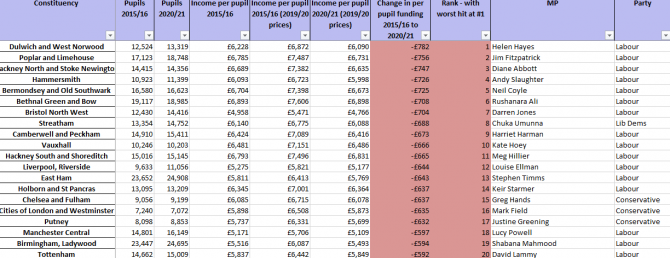A new league table that allows voters to see how their constituency has been affected by real-terms funding cuts has been published today by the National Education Union.
It’s the latest attempt by the union to put school funding at the centre of the general election campaign.
A tool previously set up by a coalition of unions was widely used in the last election. The School Cuts website allows people check how much money their local school stands to lose under funding pressures. A poll found school funding concerns caused over 750,000 voters to switch the party they intended to vote for.
The NEU said the new league tables show the “deep damage being done to England’s schools”.
VIEW THE FULL LEAGUE TABLE HERE
According to the union’s analysis, per-pupil funding in 2020 will be higher than its 2015 level in real terms in just 18 of the 533 parliamentary constituencies (3 per cent) in England.
Of the 100 worst-hit constituencies, 77 are Labour-held. Meanwhile of the 18 better-off constituencies, 13 are Conservative.
The union claimed the worst-hit constituency was Dulwich and West Norwood, in south London, which faces a £782 real-terms per-pupil funding loss next year. when compared to 2015.

Kevin Courtney, NEU joint general secretary, said: “Our constituency league table should send shockwaves through the country. The future of education hangs in the balance.
“We need real solutions and in this General Election we implore voters to scrutinise manifesto commitments closely.”
He said prime minster Boris Johnson’s pledge to up school funding by £7.1 billion by 2022 was “too little, too late”.
Johnson pledged secondaries will receive a minimum of £5,000 per pupil next year, with every primary school getting a minimum of £4,000 from 2021-22
Education secretary Gavin Williamson said the cash boost “means our schools can continue to raise standards and build an education system that boosts productivity, improves social mobility and equips children with the skills and knowledge they need to succeed in the bright future that lies ahead”.
But the union’s new analysis claims 83 per cent of schools will have less money per pupil in April 2020, in real terms, than they had in 2015.
The School Cuts website has previously been rebuked for using a “misleading” statistic that created a “worse picture” of school funding.








It’s no wonder they come to the conclusion by not including high needs funding, early years and pupil premium. Thats over 2 billion of funding not included in the calculations.
Your situation is the other side of coin of braindrain